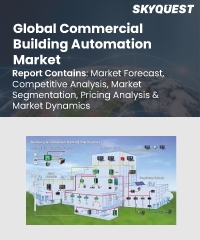USD 83.46 billion

Global Commercial Building Automation Market Size, Share, Growth Analysis, By Product(HVAC, Building Management Systems), By Entreprise Size(Small, Medium and Large), By Communication Technology(Wired and wireless technology) - Industry Forecast 2024-2031
Report ID:
SQMIG20C2062 |
Region:
Global |
Published Date: February, 2024
Pages:
157
|
Tables:
89 |
Figures:
76
Global Commercial Building Automation Market Insights
Global Commercial Building Automation Market size was valued at USD 83.46 billion in 2022 and is poised to grow from USD 91.88 billion in 2023 to USD 198.40 billion by 2031, growing at a CAGR of 10.1% in the forecast period (2024-2031).
The global commercial building automation market has been experiencing significant growth, driven by several key factors including increasing demand for energy-efficient solutions, advancements in Internet of Things (IoT) technology, and the growing emphasis on sustainable building practices. Building automation systems (BAS) play a crucial role in optimizing energy usage, enhancing occupant comfort, and streamlining building operations.
One of the primary drivers of market growth is the rising awareness among building owners and operators regarding the benefits of automation in reducing energy consumption and operational costs. With sustainability becoming a top priority for businesses worldwide, there's a growing adoption of BAS to monitor and control various building systems such as HVAC (heating, ventilation, and air conditioning), lighting, security, and access control.
These systems enable proactive management of energy usage through features like occupancy sensors, scheduling, and real-time monitoring, thereby contributing to cost savings and environmental conservation efforts.
Moreover, technological advancements in IoT and cloud computing have revolutionized the commercial building automation landscape. Integration of sensors, actuators, and other IoT devices into BAS enables remote monitoring and control of building systems from centralized platforms or mobile applications.
This connectivity facilitates data-driven decision-making, predictive maintenance, and optimization of building performance in real-time. Additionally, the emergence of smart building solutions, leveraging artificial intelligence (AI) and machine learning algorithms, further enhances the intelligence and autonomy of building automation systems, enabling adaptive and responsive control based on changing environmental conditions and occupancy patterns.
The commercial building automation market is characterized by intense competition and a rapidly evolving technological landscape. Key players in the industry are continually investing in research and development to innovate new solutions and stay ahead of the curve. Partnerships and collaborations between building automation companies and technology providers are also on the rise, fostering interoperability and the development of comprehensive solutions that meet the diverse needs of commercial building owners and operators.
Market snapshot - 2024-2031
Global Market Size
Largest Segment
Hardware
Fastest Growth
Software
Growth Rate
10.1% CAGR
To get more reports on the above market click here to Buy The Report
Global Commercial Building Automation Market Segmental Analysis
The global commercial building automation market is segmented on the basis of product, enterprise size, communication technology and region. Based on product type the market is segmented as hvac, building management systems, security and access control systems, energy management systems, lighting management systems. On the basis of enterprise the market is segmented as small, medium and large. Based on communication technology, it is segregated into wired and wireless. Based on region, the market is segmented into North America, Europe, Asia Pacific, Middle East and Africa, and Latin America.
Analysis by Product
HVAC systems have long been a cornerstone of commercial building automation due to their critical role in maintaining indoor comfort, air quality, and energy efficiency. The dominance of HVAC systems in commercial building automation is a reflection of their intrinsic importance for businesses and building owners. Whether in office spaces, hotels, hospitals, or retail outlets, maintaining a comfortable and controlled indoor environment is paramount. Furthermore, HVAC systems have evolved to incorporate energy-saving features, contributing to cost reduction and sustainability goals.
However, EMS has been one of the fastest-growing segments in recent years. Businesses are actively investing in the adoption of EMS solutions due to the increasing emphasis on energy efficiency and sustainability. These systems reduce environmental impact and reduce costs by helping monitor and control energy usage. The rapid integration of EMS in commercial buildings is because of the growing regulatory pressures and awareness of environmental responsibility.
Analysis by Enterprise Size
The commercial building automation market has been largely led by large enterprises for years. These companies generally have the resources to invest in comprehensive building automation solutions for their large-scale properties. These companies have a significant advantage in adopting advanced technologies due to their financial capacity and scale.
Though medium-sized enterprises may not top the market in comparison to the large ones, they have shown consistent growth in the commercial building automation sector. These firms are coming to realize the benefits of automation in terms of sustainability and cost savings. Medium-sized businesses are embracing automation as technology becomes more accessible and affordable in order to enhance operational efficiency.
To get detailed analysis on other segments, Request For Free Sample Report
Global Commercial Building Automation Market Regional Insights
The global commercial building automation market has been traditionally dominated by North America for several reasons, such as its high level of awareness regarding the importance of energy efficiency and sustainability, early adoption of advanced technologies, and a dynamic commercial real estate sector. With a mature market and a significant number of commercial buildings equipped with automation systems, the United States, in particular, has been a major driver of market growth in the region. Canada’s focus on the innovation of cutting-edge building automation solutions also largely contributes to the North American market,
On the other hand, the adoption of building automation systems in countries like China, India, and Southeast Asian nations has established the Asia-Pacific region as the fastest-growing market due to rapid urbanization, expanding commercial infrastructure, and increasing awareness of energy conservation. The APAC region holds promise for future expansion in the commercial building automation sector as the need for more efficient and sustainable building operations grows.
- Largest
- Fastest
To know more about the market opportunities by region and country, click here to
Buy The Complete Report
Global Commercial Building Automation Market Dynamics
Drivers
Sustainability and Energy Efficiency
- Global firms and companies worldwide are now heavily committed to reducing their operating costs and carbon footprint. Through features like smart lighting, HVAC control, and energy management, building automation systems offer an effective solution to optimize energy consumption. The adoption of these technologies has been largely affected by incentives and regulations that promote eco-friendly practices and energy savings. The demand for commercial building automation continues to rise as a result of environmentally conscious goals becoming more prominent across industries, making it a major driver of market growth.
Restraints
Cost and Implementation Challenges
- The complex implementation process and an expensive upfront investment is one of the major restraints in the adoption of commercial building automation systems. The installation and integration of advanced automation technologies into existing building infrastructure can require a substantial capital investment, posing a financial barrier for many businesses that are looking to enter the market. Additionally, the need for extensive rewiring and compatibility issues can make retrofitting older structures even more difficult. Several organizations looking to adopt these technologies will be cautioned due to concerns about the return on investment (ROI) and high initial expenses.
Request Free Customization of this report to help us to meet your business objectives.
Global Commercial Building Automation Market Competitive Landscape
A wide and varied array of companies offering a wide range of products and services makes up the competitive landscape of the global commercial building automation market. In order to meet the evolving needs of the commercial real estate sector, these firms are continuously working to innovate and provide comprehensive solutions. They are captured in intense competition in areas such as lighting controls, smart HVAC systems, energy management solutions, and security and access control. To expand market reach and enhance the range of product offerings, many players in the market employ partnerships and collaborations as common strategies.
Additionally, in order to provide insightful information that can be implemented for building management, companies are targeting the development of user-friendly interfaces and leveraging data analytics. This fierce competition drives innovation and advancements in building automation technologies, which benefits businesses seeking to optimize their commercial spaces and offer differentiated solutions to healthcare providers and patients in the long run.
Top Player’s Company Profiles
- Honeywell International (US)
- Trane Technologies (US)
- Hubbell (US)
- Schneider Electric (France)
- Legrand (France)
- Mitsubishi Electric (Japan)
- Lutron Electronics (US)
- Crestron Electronics (US)
- Beckhoff Automation (Germany)
- Osram (Germany)
- Siemens AG (Germany)
- ABB (Switzerland)
- Robert Bosch (Germany)
- Johnson Controls (US)
- Carrier (US)
- Eaton Corporation (US)
- Ingersoll Rand (Ireland)
- Delta Controls (Canada)
- Sauter AG (Switzerland)
- Danfoss (Denmark)
Recent Developments
-
In September 2023, Johnson Controls, the global authority for smart, health-conscious, and environmentally friendly buildings launched its latest service, OpenBlue Service. Ensuring Security Device Performance, designed to help customers improve building security, reduce risk, and maximize value for their security technology investments Includes Johnson Controls' OpenBlue suite of integrated solutions, the ability to monitor security devices from manufacturers internally managed and maintained, remote support services, valuable insights from experienced engineers, and cybersecurity protection system combined with no guarantees to make it a comprehensive together offering.
-
In May 2023, Carrier announced i-Vu Pro v8.5, the latest version of software designed for i-Vu architectures. This software introduces an efficient staged download method for controller firmware upgrades, improving customers’ serviceability. Unlike traditional extraction systems that disrupt HVSC equipment performance throughout the process, the new staged method breaks the extraction process into stages, reducing downtime for HVAC equipment which is included in it.
Global Commercial Building Automation Key Market Trends
- Smart Building Integration: The increasing focus on smart building integration is one of the traditionally dominant trends that mold the commercial building automation market. For the smooth integration of various automation systems such as HVAC, lighting, security, and energy management, building owners and operators are seeking in-depth solutions. The need for improved energy efficiency, data-driven decision-making, and centralized control drives this trend. The creation of truly interconnected and intelligent commercial spaces is being greatly helped by Internet of Things (IoT) technologies, cloud computing, and data analytics, offering enhanced operational efficiency and occupant comfort.
Global Commercial Building Automation Market SkyQuest Analysis
SkyQuest’s ABIRAW (Advanced Business Intelligence, Research & Analysis Wing) is our Business Information Services team that Collects, Collates, Co-relates, and Analyses the Data collected by means of Primary Exploratory Research backed by robust Secondary Desk research.
According to global commercial building automation market analysis, the market has witnessed substantial growth in recent years, driven by increasing awareness of energy efficiency, sustainability, and the need for enhanced operational control. Organizations across various sectors are embracing automation technologies to optimize building performance, reduce operational costs, and provide better occupant experiences.
| Report Metric | Details |
|---|---|
| Market size value in 2023 | USD 83.46 billion |
| Market size value in 2031 | USD 198.40 billion |
| Growth Rate | 10.1% |
| Forecast period | 2024-2031 |
| Forecast Unit (Value) | USD Billion |
| Segments covered |
|
| Regions covered | North America (US, Canada), Europe (Germany, France, United Kingdom, Italy, Spain, Rest of Europe), Asia Pacific (China, India, Japan, Rest of Asia-Pacific), Latin America (Brazil, Rest of Latin America), Middle East & Africa (South Africa, GCC Countries, Rest of MEA) |
| Companies covered |
|
| Customization scope | Free report customization with purchase. Customization includes:-
|
To get a free trial access to our platform which is a one stop solution for all your data requirements for quicker decision making. This platform allows you to compare markets, competitors who are prominent in the market, and mega trends that are influencing the dynamics in the market. Also, get access to detailed SkyQuest exclusive matrix.
Buy The Complete Report to read the analyzed strategies adopted by the top vendors either to retain or gain market share
Table Of Content
Executive Summary
Market overview
- Exhibit: Executive Summary – Chart on Market Overview
- Exhibit: Executive Summary – Data Table on Market Overview
- Exhibit: Executive Summary – Chart on Global Commercial Building Automation Market Characteristics
- Exhibit: Executive Summary – Chart on Market by Geography
- Exhibit: Executive Summary – Chart on Market Segmentation
- Exhibit: Executive Summary – Chart on Incremental Growth
- Exhibit: Executive Summary – Data Table on Incremental Growth
- Exhibit: Executive Summary – Chart on Vendor Market Positioning
Parent Market Analysis
Market overview
Market size
- Market Dynamics
- Exhibit: Impact analysis of DROC, 2021
- Drivers
- Opportunities
- Restraints
- Challenges
- Exhibit: Impact analysis of DROC, 2021
- SWOT Analysis
KEY MARKET INSIGHTS
- Technology Analysis
- (Exhibit: Data Table: Name of technology and details)
- Pricing Analysis
- (Exhibit: Data Table: Name of technology and pricing details)
- Supply Chain Analysis
- (Exhibit: Detailed Supply Chain Presentation)
- Value Chain Analysis
- (Exhibit: Detailed Value Chain Presentation)
- Ecosystem Of the Market
- Exhibit: Parent Market Ecosystem Market Analysis
- Exhibit: Market Characteristics of Parent Market
- IP Analysis
- (Exhibit: Data Table: Name of product/technology, patents filed, inventor/company name, acquiring firm)
- Trade Analysis
- (Exhibit: Data Table: Import and Export data details)
- Startup Analysis
- (Exhibit: Data Table: Emerging startups details)
- Raw Material Analysis
- (Exhibit: Data Table: Mapping of key raw materials)
- Innovation Matrix
- (Exhibit: Positioning Matrix: Mapping of new and existing technologies)
- Pipeline product Analysis
- (Exhibit: Data Table: Name of companies and pipeline products, regional mapping)
- Macroeconomic Indicators
COVID IMPACT
- Introduction
- Impact On Economy—scenario Assessment
- Exhibit: Data on GDP - Year-over-year growth 2016-2022 (%)
- Revised Market Size
- Exhibit: Data Table on Global Commercial Building Automation Market size and forecast 2021-2027 ($ million)
- Impact Of COVID On Key Segments
- Exhibit: Data Table on Segment Market size and forecast 2021-2027 ($ million)
- COVID Strategies By Company
- Exhibit: Analysis on key strategies adopted by companies
MARKET DYNAMICS & OUTLOOK
- Market Dynamics
- Exhibit: Impact analysis of DROC, 2021
- Drivers
- Opportunities
- Restraints
- Challenges
- Exhibit: Impact analysis of DROC, 2021
- Regulatory Landscape
- Exhibit: Data Table on regulation from different region
- SWOT Analysis
- Porters Analysis
- Competitive rivalry
- Exhibit: Competitive rivalry Impact of key factors, 2021
- Threat of substitute products
- Exhibit: Threat of Substitute Products Impact of key factors, 2021
- Bargaining power of buyers
- Exhibit: buyers bargaining power Impact of key factors, 2021
- Threat of new entrants
- Exhibit: Threat of new entrants Impact of key factors, 2021
- Bargaining power of suppliers
- Exhibit: Threat of suppliers bargaining power Impact of key factors, 2021
- Competitive rivalry
- Skyquest special insights on future disruptions
- Political Impact
- Economic impact
- Social Impact
- Technical Impact
- Environmental Impact
- Legal Impact
Market Size by Region
- Chart on Market share by geography 2021-2027 (%)
- Data Table on Market share by geography 2021-2027(%)
- North America
- Chart on Market share by country 2021-2027 (%)
- Data Table on Market share by country 2021-2027(%)
- USA
- Exhibit: Chart on Market share 2021-2027 (%)
- Exhibit: Market size and forecast 2021-2027 ($ million)
- Canada
- Exhibit: Chart on Market share 2021-2027 (%)
- Exhibit: Market size and forecast 2021-2027 ($ million)
- Europe
- Chart on Market share by country 2021-2027 (%)
- Data Table on Market share by country 2021-2027(%)
- Germany
- Exhibit: Chart on Market share 2021-2027 (%)
- Exhibit: Market size and forecast 2021-2027 ($ million)
- Spain
- Exhibit: Chart on Market share 2021-2027 (%)
- Exhibit: Market size and forecast 2021-2027 ($ million)
- France
- Exhibit: Chart on Market share 2021-2027 (%)
- Exhibit: Market size and forecast 2021-2027 ($ million)
- UK
- Exhibit: Chart on Market share 2021-2027 (%)
- Exhibit: Market size and forecast 2021-2027 ($ million)
- Rest of Europe
- Exhibit: Chart on Market share 2021-2027 (%)
- Exhibit: Market size and forecast 2021-2027 ($ million)
- Asia Pacific
- Chart on Market share by country 2021-2027 (%)
- Data Table on Market share by country 2021-2027(%)
- China
- Exhibit: Chart on Market share 2021-2027 (%)
- Exhibit: Market size and forecast 2021-2027 ($ million)
- India
- Exhibit: Chart on Market share 2021-2027 (%)
- Exhibit: Market size and forecast 2021-2027 ($ million)
- Japan
- Exhibit: Chart on Market share 2021-2027 (%)
- Exhibit: Market size and forecast 2021-2027 ($ million)
- South Korea
- Exhibit: Chart on Market share 2021-2027 (%)
- Exhibit: Market size and forecast 2021-2027 ($ million)
- Rest of Asia Pacific
- Exhibit: Chart on Market share 2021-2027 (%)
- Exhibit: Market size and forecast 2021-2027 ($ million)
- Latin America
- Chart on Market share by country 2021-2027 (%)
- Data Table on Market share by country 2021-2027(%)
- Brazil
- Exhibit: Chart on Market share 2021-2027 (%)
- Exhibit: Market size and forecast 2021-2027 ($ million)
- Rest of South America
- Exhibit: Chart on Market share 2021-2027 (%)
- Exhibit: Market size and forecast 2021-2027 ($ million)
- Middle East & Africa (MEA)
- Chart on Market share by country 2021-2027 (%)
- Data Table on Market share by country 2021-2027(%)
- GCC Countries
- Exhibit: Chart on Market share 2021-2027 (%)
- Exhibit: Market size and forecast 2021-2027 ($ million)
- South Africa
- Exhibit: Chart on Market share 2021-2027 (%)
- Exhibit: Market size and forecast 2021-2027 ($ million)
- Rest of MEA
- Exhibit: Chart on Market share 2021-2027 (%)
- Exhibit: Market size and forecast 2021-2027 ($ million)
KEY COMPANY PROFILES
- Competitive Landscape
- Total number of companies covered
- Exhibit: companies covered in the report, 2021
- Top companies market positioning
- Exhibit: company positioning matrix, 2021
- Top companies market Share
- Exhibit: Pie chart analysis on company market share, 2021(%)
- Total number of companies covered
Methodology
For the Global Commercial Building Automation Market, our research methodology involved a mixture of primary and secondary data sources. Key steps involved in the research process are listed below:
1. Information Procurement: This stage involved the procurement of Market data or related information via primary and secondary sources. The various secondary sources used included various company websites, annual reports, trade databases, and paid databases such as Hoover's, Bloomberg Business, Factiva, and Avention. Our team did 45 primary interactions Globally which included several stakeholders such as manufacturers, customers, key opinion leaders, etc. Overall, information procurement was one of the most extensive stages in our research process.
2. Information Analysis: This step involved triangulation of data through bottom-up and top-down approaches to estimate and validate the total size and future estimate of the Global Commercial Building Automation Market.
3. Report Formulation: The final step entailed the placement of data points in appropriate Market spaces in an attempt to deduce viable conclusions.
4. Validation & Publishing: Validation is the most important step in the process. Validation & re-validation via an intricately designed process helped us finalize data points to be used for final calculations. The final Market estimates and forecasts were then aligned and sent to our panel of industry experts for validation of data. Once the validation was done the report was sent to our Quality Assurance team to ensure adherence to style guides, consistency & design.
Analyst Support
Customization Options
With the given market data, our dedicated team of analysts can offer you the following customization options are available for the Global Commercial Building Automation Market:
Product Analysis: Product matrix, which offers a detailed comparison of the product portfolio of companies.
Regional Analysis: Further analysis of the Global Commercial Building Automation Market for additional countries.
Competitive Analysis: Detailed analysis and profiling of additional Market players & comparative analysis of competitive products.
Go to Market Strategy: Find the high-growth channels to invest your marketing efforts and increase your customer base.
Innovation Mapping: Identify racial solutions and innovation, connected to deep ecosystems of innovators, start-ups, academics, and strategic partners.
Category Intelligence: Customized intelligence that is relevant to their supply Markets will enable them to make smarter sourcing decisions and improve their category management.
Public Company Transcript Analysis: To improve the investment performance by generating new alpha and making better-informed decisions.
Social Media Listening: To analyze the conversations and trends happening not just around your brand, but around your industry as a whole, and use those insights to make better Marketing decisions.
Global Commercial Building Automation Market Report Snapshots
Want to customize this report?
Our industry expert will work with you to provide you with customized data in a short amount of time.
REQUEST FREE CUSTOMIZATION



 USA (+1) 351-333-4748
USA (+1) 351-333-4748
